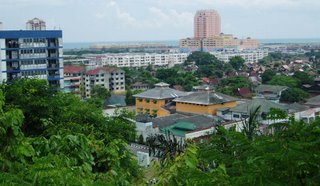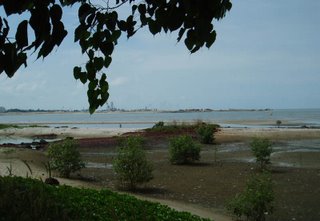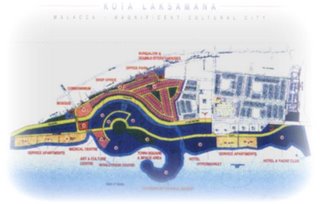The water margin
Here’s a bad dream. Imagine you're on a boat leading to Venice, its hull cutting the lapping waves silently. Your palms sweat in anticipation of the experience ahead. Then your eyes pop.
Straight ahead, newer buildings – some very tall, some faux-botteghe types – present themselves as lighthouses to a 'revitalized' Veneto region. The ferryman pulls over to dock at a spanking new harbour; you know, one of those blob designs with plenty of glass and steel.
Try as you might, you cannot see the historic Lido beachfront. The original Lido of Lidos, nature’s gateway to the Venetian archipelago. You ask the ferryman. “Oh, that’s another 3km inland,” he replies fluently in the international language you speak. “We are on reclaimed land. Progress, man. Economics.”
“All this, from here around to Murano and one-third of the Canale di San Marco is now terra firma. New, new, all new! It is good. You can walk to the Piazza San Marco now. No floods, no smells. Massage? You like entertainment? Shopping?”
******
Wake up.
That’s not Venice, can never be Venice. Despite its shortage of land, despite the annual floods, despite the obvious sanitation problems, Venice wrestles with these issues but treasures its heritage above all. Its history has been meticulously recorded by scholars, simplified to pop level for tourists, and continues to be spun. Artists, musicians and writers reach for its essence. Italo Calvino alluded to it in Invisible Cities, Joseph Brodsky in Watermark. Venice remains a living pearl, ever-growing layer by layer and never subsumed.
No, that’s not Venice. Wake up, wake up to reality.
The story of Melaka is a vivid tale which can only be told from the point of a water’s edge. It is Gita Bayu - a settlement carved from the tradewinds. It was a truly global city in its time and, in that context, rivaled by few – not in Europe, not the Far East. For here, the twain did meet.
It was on this sandy margin where Parameswara, the Sumatran prince, fleeing from the ghosts of his testosterone, arrived by sea perhaps in a gang of perahus. He made it his estate and named it after a tree. The man knew his PR, I guess. In time, Melaka grew as a seaport where merchants from Arab, India, Siam, China and the surrounding islands steered in, rested and traded. Silk must been unfurled, camphor and sandalwood burned, ceramicware stacked on shelves, jade traded alongside jaspers. I imagine the air was thick with the scent of spices, the ground coloured from their spills. And the music and languages and food.
It was on this margin legends of the Malay warrior were born. Perhaps they trained and meditated near the rocky escarpment at Tanjung Kling, perhaps at a gelanggang by the river, we’ve yet to know.
It was on this margin the Ming Dynasty Admiral Cheng Ho moored during his Imperial expeditions in the 1400s. Melaka was more than a pitstop for the 300 ships that comprised his enormous armada. It was the warm quarters of a good friend, a place to strengthen the body and spirit before the next leg.

It was this margin, whose real estate was so valuable, Europe just had to own it. The Portuguese snatched it over blood, then the Dutch, then the British, in a game of musical chairs lasting almost five centuries. A fort rose out of the laterite; a town grew from inside and around it. Bridges crossed the river. Brick structures began replacing wood construction. Churches, temples and mosques were built. Schools too, along with other institutional buildings.
On Feb 20, 1956, Tunku Abdul Rahman fresh from a successful mission in London, announced at Bandar Hilir’s Dataran Pahlawan that the Merdeka Agreement had been signed. We shall be free, the Tunku promised at the park by the water; and indeed a year later we were.
The Water Margin – old Melaka’s real-life storybook. By the 1980s, it was gone. In a frenzied, ill-informed move, the government allowed land reclamation right onto the richest page of Malaysia’s history. For me, this devastating decision is akin to the burning of libraries in many civilizations past.

Today, at the Bandar Hilir side is the reclaimed Melaka Raya, pushing the shoreline a further 3km out. Beneath it, on the original sea bed are artifacts and stories, an actual maritime museum of Chinese junks, perahus, Dutch and Portuguese ships forever entombed under sand and rock that supports Mahkota Parade today.
It happened in my lifetime. I remember as a kid being on a family trip to Melaka. It must have been the mid-70s before Saturday Night Fever. A Formosa was a stroll away from the water’s edge as St Paul’s Hill rose up quite suddenly. Melaka’s tip was essentially a promontory. Its layout made sense. There is an organic logic to its settlement pattern. Behind Tranquerah was the sea. Shops such as the row where the Baba Hotel is today had backs that reached over water. In the mornings, servants of these dwellings would open trapdoors and walked down ladders to boats bearing fish and vegetables. The market floated to your backdoor. Today it is Taman Kota Laksamana, a housing area like any other in any Malaysian town.
Just great. Visionary idea. A++.
Why so? Did it meet with resistance? Is Melaka so land-strapped it has to resort to such foolish, short-sighted moves? I cannot find the answer nor can I accept it.


The nightmare continues today.
Land reclamation is proceeding northwards along the Klebang coast. The pattern is clear. About 3km away from town, a signboard on hoarding is up with an Evora Business Park announcing some oncoming paradise of offices. In time to come, tall buildings will obscure your view of the sea as you drive along the Klebang coastal road. You would have forgotten that it was here fishermen mingled with the rich, sharing a smoke and a prize catch together. Never mind that further up, Tanjung Kling was a vibrant Malay settlement in its time. That may be defaced as well, artificially pushed inland by land reclamation. In the scale of local economics, history is cheap, the senses only rewarded to those who can pay.
They made the same mistake with Port Dickson; miles of beachfront have been converted to resorts and denied public access. The drive from Port Dickson town along the Teluk Kemang coastal road was once a great treat to the senses. Today, a wall of private hotels and service apartments block that view. In what was once a perfect weekend laze-about amongst idyllic casuarinas is now a pay-per-view commodity. Port Dickson failed its people.
Please, not Melaka. This isn’t renaissance. True progress embraces history, soars on its currents, never suffocating it.
In the not too distant future, the people could plausibly appreciate – why, demand to know – Melaka’s larger history, for instance its sister relationship with Muar of which another Portuguese fort once stood. Conceivably, boutique hotels will occupy the present Dutch houses in Muar and boat cruises will ply this historic route offering a different view of the water margin. Pagoh, Batu Pahat, and Alor Gajah are awaiting a true masterstroke which can release the latent spirit of this locale and return it to a renewed vigour. All it takes is sensitivity and a little imagination.

Melaka is a settlement carved from the tradewinds. Like Venice, like Goa. For the tales yet uncovered, for respect of history, for heritage and for commonsense, Melaka’s coastal aura must remain. Remove that and you remove its soul.

No comments:
Post a Comment